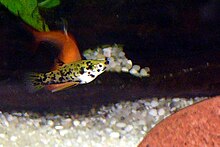bio.wikisort.org - Animal
The dusky millions fish, speckled mosquitofish or the one-spot livebearer (Phalloceros caudimaculatus) is a species of fish native eastern and southern Brazil, northern Argentina, Uruguay and Paraguay.[1] It has also been introduced to Australia, Malawi and New Zealand; primarily for mosquito control, but also as escapees from the aquarium trade.[1] It has been reported as having adverse ecological effects in areas where it has been introduced.[1] The females of this species grow to a total length of 6 centimetres (2.4 in), while males remain smaller.[1]
| Dusky millions fish | |
|---|---|
 | |
| Scientific classification | |
| Kingdom: | Animalia |
| Phylum: | Chordata |
| Class: | Actinopterygii |
| Order: | Cyprinodontiformes |
| Family: | Poeciliidae |
| Genus: | Phalloceros |
| Species: | P. caudimaculatus |
| Binomial name | |
| Phalloceros caudimaculatus (R. F. Hensel, 1868) | |
| Synonyms[1] | |
|
Girardinus caudimaculatus Hensel, 1868 | |
Origins
This species originated in South America.[2] It is mainly a freshwater fish and thrives best in areas with weak water flow.[2] However, it is extremely adaptable and can thrive in a multitude of altered environments.[2] For example, although it prefers temperatures between 16 and 22 °C (61–72 °F), it can survive up to 30 °C (86 °F)[3] and down to 5 °C (41 °F).[2] The species also has a high fecundity.[4]
The dusky millions fish was one of the first species in its family, the Poeciliidae to be bred for aquarium usage.[2] Ecologists also attempted to use the fish as a mosquito control; however, the mosquito fish's diverse diet affected its efficacy as a control species.[2] The mosquito fish can eat a range of different organisms, including algae.[2]

Role as an invasive species
The dusky millions fish was introduced to a variety of ecosystems both by aquarium keepers and as mosquito pest control.[2] The NSW area of Australia has been affected the most by its presence.[2] It reproduces and spreads well in the winter when there is a larger flow of water.[2] Australian ecologists have tried to contain this spread by killing them with rotenone; however, the infestation persists.[2] This species is most likely to be found in shallow areas with varying levels of vegetation, such as local ponds.[4]
The ecological impact of the dusky millions fish in Australia is pronounced. Its diet has affected populations of both native and non-native fish.[4] An example would be the non-native species Gambusia holbrooki.[4] It has similar features as the dusky millions fish, such as a high reproductive rate and use for mosquito control.[4] However, its population in Australia has diminished since the introduction of the dusky millions fish.[4] Furthermore, this dusky millions fish has also affected the food chain, as they have become prey for native bird species.[4]
References
- Froese, R; Pauly, D (eds.). "Phalloceros caudimaculatus summary page". FishBase. Retrieved 2015-11-23.
- Maddern, M.G. (2008). "Distribution and spread of the introduced One-spot Livebearer Phalloceros caudimaculatus (Pisces: Poeciliidae) in southwestern Australia" (PDF). Journal of the Royal Society of Western Australia (91): 229–235. Retrieved November 23, 2015.
- SeriouslyFish: Phalloceros caudimaculatus. Retrieved 21 March 2017.
- Rowley, J. J. L.; Rayner, T. S.; Pyke, G. H. (2005-09-01). "New records and invasive potential of the poeciliid fish Phalloceros caudimaculatus". New Zealand Journal of Marine and Freshwater Research. 39 (5): 1013–1022. doi:10.1080/00288330.2005.9517372. ISSN 0028-8330.
На других языках
- [en] Dusky millions fish
[es] Phalloceros caudimaculatus
La madrecita (Phalloceros caudimaculatus)[2] es una especie de pez actinopeterigio de agua dulce,[3][4] de la familia de los poecílidos.[5] Se comercializa para su uso en acuariofilia.[2][ru] Уругвайский фалоцер
Уругвайский фалоцер[1] (лат. Phalloceros caudimaculatus) — вид живородящих лучепёрых рыб семейства пецилиевых, обитающая в Южной Америке.Другой контент может иметь иную лицензию. Перед использованием материалов сайта WikiSort.org внимательно изучите правила лицензирования конкретных элементов наполнения сайта.
WikiSort.org - проект по пересортировке и дополнению контента Википедии